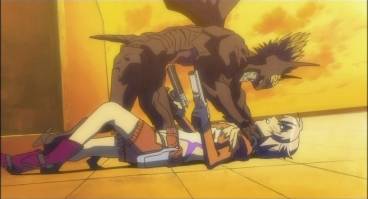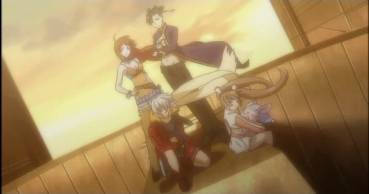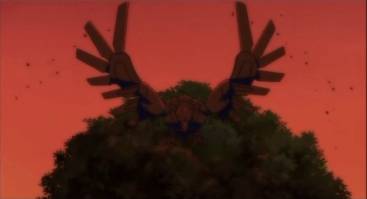|
Burst
Angel Vol. 2 – A New Tokyo (released 13th March) is
a breath of fresh air in what has become a rather stale
genre of animé as of late. It harks back to the episodic,
one-story-at-a-time narrative structure that I enjoyed with Cowboy Bebop and Outlaw Star, while at the
same time breathing new life into an old formula: a group
of mercenaries that band together to fight crime and demons
with large guns and mecha.

Indeed,
there isn't much more backstory or reasoning to go on. The
four main characters of the story – whom I'll go over in
more detail later – are introduced as jobbing teenaged mercenaries,
who primarily work for a company named Bai Lan. This company
is run by the grandfather of one of the four, Sei. Together,
they fight against criminals in future Tokyo, as well as
some more demonic activity that they treat no differently.
The only other piece of relative information I can impart
for those of you who want to purchase Volume 2 before Volume
1 is that there's a new law in Tokyo – civillians are permitted
to carry firearms, and the new armed response division of
the Tokyo Police is resorting to lethal force in order to
control the populace. This provides the motivation for a
secretive mercenary team, as well as shadowing the backdrop
of events during the series.Our
four main protagonists – three of them the spitting image
of the main characters from Evangelion – are the
cryptic and aloof, androgynous Jo; spunky cowgirl-wannabe
Meg; cute but deceptive computer whiz Amy; and upright,
all-business Sei. Along for the ride is Kyohei, their cook,
who's usually roped into helping them out on missions –
much to his chagrin. The three leading ladies are your stereotypical
animé warrior girls, more often than not dressing
in skintight, revealing outfits, regardless of their usefulness
in armed combat. The level of fanservice is nowhere near
as bad as in Battle Vixens – it's typical of most
series to show their female cast in overtly sexual costumes
and positions – but it's pronounced further by the main
characters all being female.Volume
2 contains four episodes. The series takes the Justice
League turn of splitting one story into two parts, so
there are only two distinct stories in this volume. As I
mentioned before, the episodes are largely self-contained,
with only the vaguest hint of a backstory in each one.05:
"Mansion Where Lurks the Demon"06:
"Wash This Garden With Blood!" Meg goes undercover at
an elite private school, to investigate rumours that some
of the students are taking hallucinogenic drugs and possibly
conjuring demons. She's unable to adapt to the unfamiliar
environment, but manages to muddle through. When things
get too tough for her to handle, Jo steps in and joins her
in her search to uncover the mystery of the school.07:
"Black Sky"08:
"The Wounded Outlaw" A huge mechanical crow
is snatching young girls from the streets of Tokyo. When
Meg is captured by the creature, Jo rebels against Sei's
instructions and sets out to rescue her – at all costs.
Kyohei is caught right in the middle, finding himself used
as a human bargaining chip.

It's
in the second of the two stories that the relationship between
Jo and Meg is thrown out into the open. In the first story,
the implied relationship between the two of them is made
quite clear through dialogue – but it's only in the second
story that the viewer begins to understand the nature of
their relationship. Jo is hugely protective of Meg, forgetting
all her responsibilities and doing literally anything in
an effort to save her. If I were Sei, I wouldn't want my
strike force's strongest member to go off like a bull at
a red flag every time her teammate finds herself in danger.
I'd consider it a danger to the team. I wonder how much
Sei is willing to tolerate Jo's wilful lack of respect for
authority figures, and I hope this aspect of the story is
built upon in later episodes.The
English voice-acting work just didn't sit too well with
me. While the English voice-actors' line delivery isn't
emotionless, some characters tend to put emotional stresses
upon the wrong syllables, and this makes certain lines seem
completely out of place. Music ranges from upbeat and peppy
action tracks for the first story, to tracks that wouldn't
seem out of place in one of Sergio Leone's spaghetti westerns
in the second. The English narrator also has a wonderful
Western drawl. The opening theme is the usual techno-rap-dance-JPop
that I've seen in recent animés, but the closing
theme did catch my eye (or ear) – it might just sound like
all the other animé closing themes out there, but
I found it nice.The
artists have used a faded, muted colour scheme, and lots
of overexposed white backgrounds. We've seen this before,
in Gunslinger Girl, where I think it worked a little
better. Unlike the characters of that series, these girls
have fully developed personalities and eotions, and the
effect of this lighting simply drains them of life. Eye
colours are bright and solid, and often convey facets of
the character's personality – take note of the character
Angelique, from the first story, whose eyes just scream
"Evil". And I was seriously impressed by Studio Gonzo's
CG work on the mecha combat scenes of the second story –
the 2D and 3D animation styles blend almost seamlessly,
and are simply a joy to watch.Overall,
in case you hadn't picked up on this, I'm really enjoying
this series. It's got a story ethic that lets new viewers
jump in at (almost) any point; the stories aren't confined
to one episode and so can be made longer, without feeling
as though they're dragging the series into a long story
arc; music and visual effects are used well; and there's
some decent characterisation. My only real gripe is that
the English VAs aren't quite as good as most of the recently-released
animé out there – the washed-out skintones, I can
live with. If you enjoy not having to view an entire series
from the very beginning to "get" the plot threads, and simply
want some decent action-combat animé to put on at
the end of a long day, I wholeheartedly recommend Burst
Angel.
1.85:1
and anamorphically enhanced, the transfer is decent enough,
with good colour and reasonable sharpness – the slightly
over-exposed and diffused look in some scenes appears to
be deliberate and is a trait that can be found on some other
recent animé series.

There
are two soundtracks, both 5.1 surround, one Japanese, one
English. The English track is slightly fuller than the Japanese
original, and the voices have been treated (added reverb
etc.) to make them suit the location, something the original
Japanese voices have not. The music has slightly more punch
on the English dub.
Extra
features on Burst Angel are, like most MVM discs, quite
satisfying. There's an audio commentary track for episode 08, "The Wounded Outlaw", with the English
VA director and the voices of Jo and Sei. Having heard Greg
Ayres (here the voice of Kyohei)'s commentary track on Chrono
Crusade, I was slightly disappointed that they didn't
ask him to record one this time around – given that the
episode in question features a bond forming between Jo and
Kyohei.There
are some Radio Dramas – one main track (16:35)
and two bonus tracks (3:55 and 3:35) – featuring the Japanese
voice-actors in their own Burst Angel radio show,
where they get to grips with Japanese tongue-twisters and
act out skits sent in by fans.Finally,
you can view clean opening and closing animations
(and hear the Japanese closing theme), and watch trailers
for Samurai 7 and Battle Vixens.
|